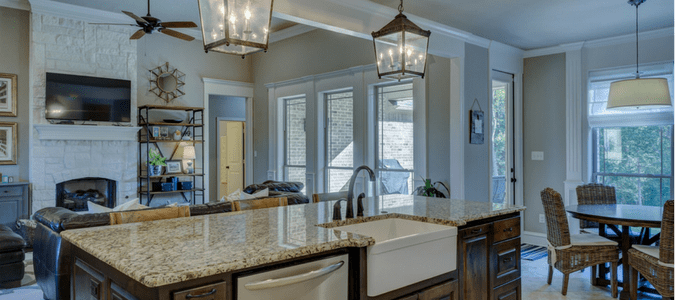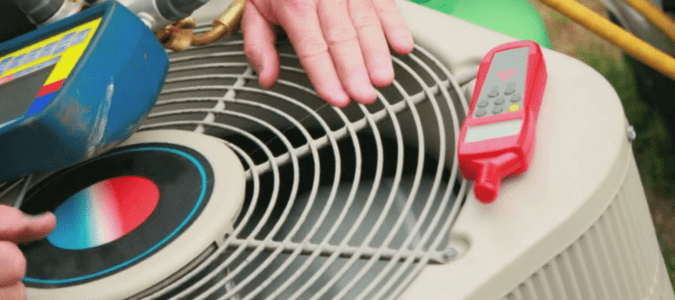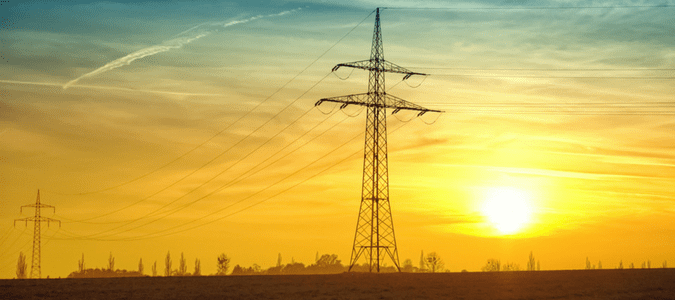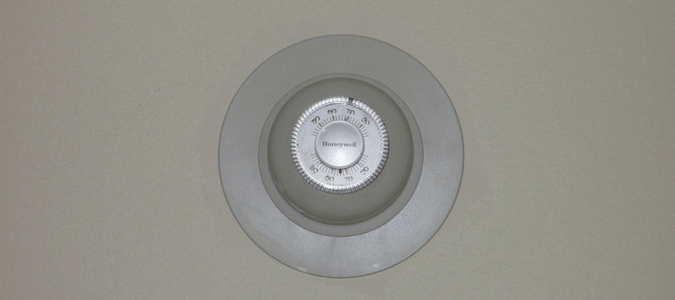
Although most of us just think of these appliances as our air conditioner or heater, it’s our HVAC system that heats and cools the air in our home, making our hot summers bearable and keeping the inside of our homes cozy during our infrequent cold snaps. We rely on these systems to keep us comfortable when we are indoors, but few of us know exactly how HVAC systems work.
The four main components of the typical HVAC system are the outside condenser, inside furnace, evaporator coil and duct system. The process of cooling your air starts with the condenser, where the refrigerant is compressed into a liquid and piped inside to the evaporator coil. Air is drawn from the home by the furnace, which blows through the evaporator coil. In the evaporator coil, the refrigerant expands into a gas and becomes very cold, absorbing the heat as it passes through, thereby cooling the air. The cool air is then distributed through a duct system to each room. The supply duct is connected to the evaporator coil. Cool air blows into each room through a supply register, more commonly known as a “vent”. Your filter is designed to keep the air clean in your home.
According to the Department of Energy, three-fourths of all homes in the United States have air conditioners, which use about six percent of the electricity produced in the US at an annual cost of approximately $29 billion to homeowners. Knowing how to maintain this investment can go along way toward reducing your energy bills.
In this post, we’ll explore how a central air conditioner works, what the term “central heat and air” actually means, if air conditioning is powered by gas or electric, how to use an air conditioner effectively and how to maintain your unit.

How Does a Central Air Conditioner Work?
In a nutshell, your central air conditioner pulls in warmer air from inside your home, cools it down by removing the heat and re-distributes it through your home. Technically, the refrigerant is absorbing the heat in your home and then the heat is removed as it moves through the condenser outside. Although you may want to delve deeper, what you really need to know is that your HVAC system is a very complex system that keeps you and your family comfortable throughout the year.
Everything starts with your thermostat. You tell your system what you want it to do when you set a temperature. By changing the temperature, you direct your system to either heat or cool your home. Your thermostat can be set to operate either manually or automatically. Depending on how advanced your thermostat is, you can control your home environment through your phone, computer or a voice-controlled personal assistant like Amazon’s Echo or Google Home.
The filter works to remove particles from the air in your home and keeps them from getting into the air conditioning unit and therefore from moving these particles around your home. Changing the filter on a regular basis will help keep the air flowing properly in your home and prolong the life of the equipment.
The outdoor fan moves air through the unit and over the condenser and the blower pulls in warm air.
The compressor or condensing unit is outside and converts the refrigerant from gas to liquid before sending it to the evaporator coils. The refrigerant moves through the coils, cooling the air and is then moved through the supply ducts in your home. Warmer air is sucked into the return ducts and the whole process starts over.
What is Central Heat and Air? Air Conditioner Types Explained
Central heat and air systems circulate the air in your home through a system of supply and return ducts and registers (or vents) instead of a room air conditioner unit (also called a packaged system), ductless mini-split or evaporative cooler.
HVAC is also usually known as a split system because it has parts both inside and outside of your house. Typically a central heat and air system usually has the air conditioning part outside and the furnace inside.
Zoned systems are also HVAC systems that allow you to heat and cool different parts of your home separately by opening and closing valves or dampers in your ductwork. If you have a home where you don’t always use rooms or don’t use all of your rooms all day, this type of unit can save you money in the long run.
A ductless mini-split system features a heat pump or air conditioner, a small fan coil and wires that connect an outdoor unit to the fan coil. These units are mounted on a wall and usually only serve one room per system. Ductless mini-split systems are generally very efficient and can be a good alternative for cooling areas if you don’t have ductwork installed. Mini-split systems work best in homes that were designed and built for that particular type system. They are also very well suited for use in a garage or one room.
A packaged system contains the evaporator, condenser and compressor in one small unit. Most people call these types of air conditioners window units. This type of system typically lasts 10-15 years. The main problem with this type of system is air leaking because of improper installation, which can increase your energy bills. However, the unit itself is much less expensive than an HVAC system, especially if you only need to heat or cool a small area.
An evaporative cooler adds moisture in addition to cooling the air. If you live in an area with high humidity, this is not a unit you will want to consider. This type of air conditioner requires more maintenance than a central air heat and air unit but costs significantly less. An evaporative cooler needs to be frequently cleaned and drained, but it can last 15-20 years.
Does Air Conditioning Use Gas or Electric?
Many homeowners want to know whether HVAC systems are powered by gas or electric energy. The answer is that your system is run by both, depending on the time of year. An air conditioner uses electricity, which is why you see your electric bill go up in the hot summer months. If your home has a gas option, your furnace is probably gas. In some cases, heaters are electric. But in most cases, HVAC systems utilize both electric and gas.
Other components of your HVAC system draw power from different sources. The thermostat uses electricity, as well as the heat pump. When the temperature drops, you should see some relief in your energy bills if you live in warmer climates since your air conditioner is typically not on.
If you see that your bills are increasing year over year, or if your HVAC unit is more than 10 years old, then it may be time to consider replacing your unit, especially if it’s needed a lot of recent repairs.
There are also other ways to reduce your energy bills. Homeowners can try:
- Using ceiling fans so that you can turn up your thermostat without sacrificing your comfort.
- Using exhaust fans, like the fan in your bathroom, when showering and the vent in your range hood when cooking to help remove the heat and humidity from your home. Removing warm air by using these fans reduces the amount of work your HVAC system has to do.
- Installing energy efficient curtains or shades to prevent sunlight from entering your home, which can drive up the temperature in warmer months. These window coverings help reduce the wear and tear on your HVAC system since they can keep your home cooler so that your system does not to be on as much.
- Insulating your attic and ducts and sealing cracks to prevent your heated or cooled air from escaping.
How to Use Air Conditioner Effectively
Keeping your HVAC system well-maintained will go a long way toward keeping your air conditioner and heater running efficiently and effectively. A maintained system normally lasts 15-20 years. There are several things homeowners will want to do to extend the life of their unit. To maximize the efficiency of your HVAC system:
- Mow and remove grass and other vegetation around your outdoor unit.
- Clean and check your evaporator coils once per year. If they freeze up, your system may have restricted airflow from a dirty air filter or not enough refrigerant. If you don’t have enough refrigerant, you may have a leak.
- Clean or replace your air filter as needed.
- Clean out drain channels with a wire to prevent clogs.
- Use a special fin comb to straighten out any bent coils.
- Clear your condensate drain each year with a mixture of bleach and water to prevent mold buildup.
- Check your refrigerant line.
When you see repeated problems with your air conditioner or heater, you may start to wonder if it’s time to replace your air conditioner.
Energy Star offers the following checklist to help you decide whether it’s time to replace your unit. Consider getting a new HVAC system if:
- Your heat pump or air conditioner is more than 10 years old. Air conditioners now have minimum SEER rating of 13 and the more efficient refrigerant of R410A.
- Your furnace or boiler is more than 15 years old.
- Your HVAC unit needs frequent repairs and your energy bill increases year over year.
- You have a hard time heating or cooling some rooms in your home.
- You have humidity problems in your home.
- You have excessive dust in your home.
- Your HVAC system is loud or noisy.
The decision about whether to repair or replace is always big, whether you are thinking about getting a car or an HVAC system. If you have an AC repair person who tells you that you have a refrigerant leak or that your compressor needs to be replaced and your system isn’t new, you may want to weigh the cost of that expensive repair versus replacing the entire unit.
Take Advantage of ABC’s HVAC Expertise For Your Home
The professionals at ABC Home & Commercial Services have extensive experience in maintaining, repairing and installing HVAC systems. Whether you’re having problems with heating and cooling, need your system replaced or just need preventative maintenance, our experts have you covered. With ABC’s help, you won’t need to become an expert on HVAC systems and you can spend your time enjoying the comfort of your home.



